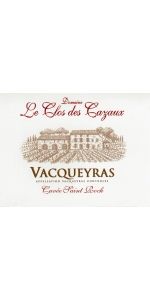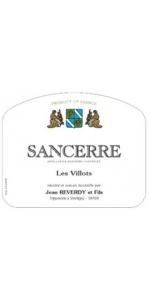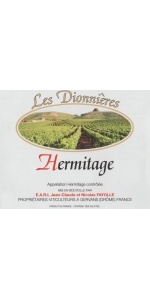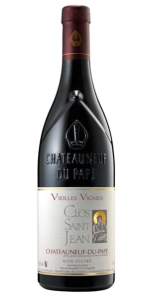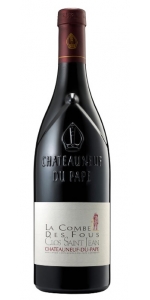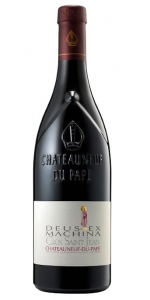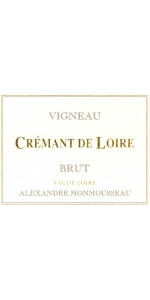Colline Saint Jean Vacqueyras Rouge 2010
| Country: | France |
| Regions: | Rhone Vacqueyras |
| Winery: | Colline St-Jean |
| Grape Type: | Grenache |
| Vintage: | 2010 |
| Bottle Size: | 750 ml |
Cazaux Vacqueyras Rouge Cuvee Saint Roch 70% Grenache, 25% Syrah and 5% Mourvedre.
Deep color. Intense and persistent red fruits, such as strawberry and black cherry. Expressive and delicate at the same time. The finish is long and the tannins are quite round and well balanced.
Grapes are hand picked, destemmed 100% but not crushed. About 20 days fermentation according to vintage. Aged in stainless steel tanks for 12 months and an additional 12 months in enamel coated concrete tank. No fining, light filtration.
Enjoy this wine with meat cooked in red wine sauce (such as Boeuf Bourguignon).
Reverdy Jean Sancerre Rouge is mader from 100% Pinot Noir
The wine is spicy and juicy with cherry aromas, and proves the point that power is not necessary for a fine wine.
Jean-Claude et Nicolas Fayolle Hermitage Rouge Donnieres is made from 100% Syrah.
Made from 40-year-old vines planted on granitic and rocky soils in the Lieu dit "Les Donnieres" at the bottom of the Hermitage's hill.
Intense inky ruby red color.
The wine has plenty to offer with red and black fruit aromas, as well as a good minerality.
The finish is very long, clean and juicy and offers a great spicy mouthfeel.
Soil is clay, silica and round pebbles.
Hand harvested in small crates. The grapes are then pumped into tanks (full cluster, not destemmed).
It will stay in this tank for 15 days for the skin contact maceration and the Alcoholic fermentation.
Tey will also use the "rack and return" technique (delestage).
Then the wine is transfered into neutral French Oak barrels where the wine will complete the Malo-Lactic fermentation.
Delicious with grilled red meat such as venison or lamb and most cheeses.
Clos Saint-Jean Chateauneuf Du Pape Vieilles Vignes is made from a Grenache, Syrah, Mourvedre, Cinsault, Vaccarèse and Muscardin, the Châteauneuf-du-Pape Vieilles Vignes is made from old vines located in and around Le Crau. The Grenache is aged in concrete for 12 months while the remainder is aged in demi-muid.
Review:
This has good concentration and energy to the dense core of dark fruit and bitter cherry, with great poise and elegance despite its ripeness (an impressive feat for the vintage). Guided by finely crushed mineral accents and tannins, this reveals pretty high-toned floral notes and leafy tobacco. Grenache, Syrah, Mourvedre, Cinsault, Vaccarese and Muscardin. Drink now through 2032. 900 cases made.
-Wine Spectator 95 Points
Clos Saint-Jean is a 41-hectare estate in Châteauneuf-du-Pape run by brothers Vincent and Pascal Maurel. Considered by many critics and wine-writers as the preeminent estate espousing the modern style of winemaking in Châteauneuf, this cellar is one of the oldest in the region, having been founded in 1900 by the greatgreat-grandfather of Vincent and Pascal, Edmund Tacussel. A short time after its founding and well before the AOP of Chateauneuf-du-Pape was created in 1923, Edmund began bottling estate wines in 1910.
The farming at Clos Saint-Jean is fully sustainable due to the warm and dry climate, which prevents the need for chemical inputs. Instead, Vincent and Pascal employ organic methods for pest control, mainly pheromones, to prevent pests from taking up residence in their vines, a process called amusingly enough in French, confusion sexuelle. The vines tended manually, and harvest is conducted in several passes entirely by hand.
Combe des Fous literally means, the hill of the fool. The hill, in this case, is located in the far southern reach of Le Crau which was left barren for many centuries because the layer of galets was so exceedingly deep that everyone assumed vines could never survive there. The fool in this situation is Edmund Tacussel, the great-great-grandfather of Vincent and Pascal Maruel who planted a Grenache vineyard on this site in 1905. That old-vine Grenache form the heart of this cuvée with a small amount of Syrah, Cinsault and Vaccarèse. La Combe des Fous is only made in the best vintages.
Review:
This has good concentration and energy to the dense core of dark fruit and bitter cherry, with great poise and elegance despite its ripeness (an impressive feat for the vintage). Guided by finely crushed mineral accents and tannins, this reveals pretty high-toned floral notes and leafy tobacco. Grenache, Syrah, Mourvedre, Cinsault, Vaccarese and Muscardin. Drink now through 2032. 900 cases made.
-Wine Spectator 95 Points
Clos Saint-Jean is a 41-hectare estate in Châteauneuf-du-Pape run by brothers Vincent and Pascal Maurel. Considered by many critics and wine-writers as the preeminent estate espousing the modern style of winemaking in Châteauneuf, this cellar is one of the oldest in the region, having been founded in 1900 by the greatgreat-grandfather of Vincent and Pascal, Edmund Tacussel. A short time after its founding and well before the AOP of Chateauneuf-du-Pape was created in 1923, Edmund began bottling estate wines in 1910.
The farming at Clos Saint-Jean is fully sustainable due to the warm and dry climate, which prevents the need for chemical inputs. Instead, Vincent and Pascal employ organic methods for pest control, mainly pheromones, to prevent pests from taking up residence in their vines, a process called amusingly enough in French, confusion sexuelle. The vines tended manually, and harvest is conducted in several passes entirely by hand.
Deus ex Machina is a literary and dramatic term for a miraculous intervention that interrupts a logical course of events in a plot or play. A suitable name for a cuvée that had it’s start in the torrid vintage of 2003 when Philippe Cambie and Vincent Maurel made the decision to harvest at the end of September, weeks after their neighbors. Deus ex Machina is a blend of old vine Grenache from La Crau, aged in tank with equally ancient Mourvedre from the sandy soils of BoisDauphin aged in demi-muid. Deus ex Machina is only made in the best vintages.
Review:
Lastly, the 2022 Châteauneuf Du Pape Deus-Ex Machina shows a similar profile to the Combes des Fous, yet it brings another level of tannins and concentration. Kirsch liqueur, white flowers, sandalwood, cured meats, and graphite notes all shine here, and it's full-bodied, has a deep, layered, powerful, yet weightless profile, lots of ripe tannins, and a blockbuster of a finish. This ripe, sexy, seamless, incredibly impressive beauty will compete with anything in the vintage. As usual, this cuvée is 60% Grenache and 40% Mourvedre, which is brought up in roughly 40% new demi-muids.
Review: Jeb Dunnuck 97 Points
Colline Saint Jean Vacqueyras Rouge 2010 is made from 70% Grenache, 25% Syrah, 5% Mourvèdre.
Harvested by hand.
Traditional vinification.
Skin-contact maceration for 20 days in cement vats.
Ageing: 70% in cement vats and 30% in oak barrels.
Dense ruby/purple color as well as an impressive bouquet of red and black fruits (cherry, raspberry, black currant), licorice, garrigue and pepper.
The wine is dense, full-bodied, opulent and impressively endowed with sweet, well-integrated tannins.
Pairs well with red meat, white meat, game dishes in macerate sauce and cheese.
"This family owned estate, currently run by Roland Alazard and his son, is composed of 35-hectare of vines located in Vin de Pays du Vaucluse, Cotes-du-Rhône, Vacqueyras, Gigondas and Beaumes de Venise. While they produce a number of cuvees, I was only able to taste their straight Vacqueyras for this report, and I have to say, I came away more than a little impressed as the wine showed uncommon finesses and elegance paired with serious concentration. I'm a fan and this is certainly a producer worth having on your radar screen.
A gorgeous Vacqueyras that's a blend of 70% Grenache, 25% Syrah and 5% Mourvedre aged 70% in cement tank and 30% in barrique, the 2010 Domaine de la Colline Saint Jean Vacqueyras is exotic and perfumed, yielding creamy blackberry, raspberry, lavender, spring flowers, and green peppercorn aromatics that soar from the glass. Beautifully complex and nuanced, with a full-bodied, polished texture, impeccable balance, and an overall fresh, yet decadently rich profile, this knockout 2010 should be purchased by the cases, and consumed over the coming decade. Brilliant stuff and this screaming value is well worth the effort to track down."
- Jeb Dunnuck's Rhone Report (Issue#11, March 2012), 93 pts
"This wine is a blend of 70% Grenache, 25% Syrah, and 5% Mourvedre sourced from a 14 hectares of 50 year old vines on soils of clay and limestone. The fruit was fermented with indigenous yeasts in cement vats before aging in 70% cement vat and 30% used oak barrels. Alcohol 14%. The medium strength nose reveals young pure fruit with a powerful pepper note and eventually blueberry jam. In the mouth the pepper fruit shines through as the wine puts on complexity in to the aftertaste. There are strong, fine+ drying tannins and sweet spices. On the second night the wine remains young with an added graphite note to the blueberry fruit, a racy aspect, and a dark note in the aftertaste. There is prominent structure to this modern styled wine. 2017-2025."
- Hogshead Wine Blog (September 4th 2012), ***(*)
"Plump and fleshy, with layers of linzer torte, currant confiture and cherry preserves laced with toasted anise and backed by a long, graphite-filled finish. Offers nice grip. Drink now through 2017. 5,000 cases made. –JM"
- Wine Spectator (July 31st 2012), 90 pts
The Domaine St-Jean Estate
Located in the middle of the Cotes du Rhone, in the village of Vacqueyras, at the foot of Dentelles de Montmirail, Domaine de La Colline St. Jean has been a family-owned property for several generations.
The Domaine St-Jean Vineyard
They have 35 ha of vineyards in Vin de Pays du Vaucluse, Côtes-du-Rhône, Vacqueyras, Gigondas and Beaumes de Venise. Roland Alazard and his son preserve the character and the traditions of wine producers in their Cotes-du-Rhone wines. The hillside vineyards are heated by the sun giving the resulting wine a generous crimson robe, complex flavors and a delicate roundness on the palate.
- number of hectares in Vacqueyras : 14 ha
- Number of parcels : 6 parcels
- Average age of the vines : 50 years
- Sun exposure : south
- Soil (terroir) : Clay/Limestone
- Yield : 28 hl/ha in 2010
Vacqueyras AOC represent 1,690 hectares (4,191 acres), of which only 1,300 hectares (3,224 acres) are planted with vines.
Total production for the entire Vacqueyras AOC is roughly 42,775 hectoliters (474,089 twelve-bottle-case equivalent).
Made from 50% chenin blanc and 50% chardonnay
It is an interesting experience as a sparkling wine for people who want to have a fine and elegant wine comparable to Champagne for a very good price.
This methode traditionnelle sparkling wine is aged for minimum 18-24 months in cave before disgorging. The dosage is 12 g/l residual sugar and the wine is aged for minimum 3 months after disgorging .
Review:
"The two sparkling wines should not be missed. They're both terrific examples of how good sparkling Vouvray can be. Both are 100% Chenin Blanc cuvees. Even better is the slightly richer, more honey and lemon-scented and flavored non-vintage Cremant de Loire. A blend of equal parts Chenin Blanc and Chardonnay aged for a minimum of 18 to 24 months in their cellars before disgorgement, this is a real beauty and a superb wine. Unfortunately, just under 100 cases are imported to the United States." -Wine Advocate 92 pts
- back
In 2007, production was just less than 5000 kg per hectare. This wine is prepared with Tempranillo 100% grapes from our vineyards.
The grapes are initially subjected to a six-day pre-fermentation cold maceration below 14ºC. They then undergo 30 days of alcoholic fermentation at a controlled temperature of 28ºC, after which the wine is removed from the tanks without pressing the grape skins. The malolactic fermentation is slow and relaxed at a temperature of 20 ºC for 28 days without the addition of bacteria.
The wine is aged for18 months in new French oak barrels and is decanted into new barrels every six months. At the end of this period, the wine is blended and bottled without undergoing any type of filtration, clarification or cold treatment.
Prepared with Tempranillo grapes (100%), this wine has a ruby red colour with very pure, intense garnet tones.
Its bouquet has fine complexity with tones of ripened fruit, especially cherries, blue berries and black currants, which are in harmony with tones of good wood, spices (vanilla and coconut) and a liquorice undertone.
In the mouth, this wine displays great balance, proving pleasing to the taste, sweet due to the maturity of its tannins and exuberant on account of its pleasant level of acidity.
Vineyard:
Pago de los Capellanes, Pedrosa de Duero.
Variety composition:
100% Tempranillo.
Type of soil:
Clayey and chalky.
Aging:
18 months in barrel and remainder on rack.
Type of oak:
100% French oak, medium toast.
Serving:
Uncork and decant one hour before serving at a temperature of 16-18 ºC.
The 2019 Ribera del Duero Reserva is also terrific, with gorgeous aromatics of black and blue fruits supported by Asian spices, lead pencils, cedarwood, and violets. It's beautifully textured, medium to full-bodied, has a concentrated, powerful mouthfeel, and ripe, integrated tannins.
-Jeb Dunnuck 95 Points
Chavy-Chouet Bourgogne Blanc Femelottes is made form 100 percent Chardonnay.
This is a charming, rich, focused and delightful white. Medium-bodied with a smooth texture, the wine has a fresh backbone of acidity, clean apple and citrus flavors, and an excellent balance. A most refreshing quaff and one that is great value. A delicate, expressive wine of exceptional quality.
The grapes from this wine are grown from the Puligny-Montrachet area. (either outside of the AOC limit or with younger vines).
The grapes from this wine are grown from the Puligny-Montrachet area. (either outside of the AOC limit or with younger vines).
Aged 10 months in oak barrels (10% new, the rest in 2-3 year old barrels).


